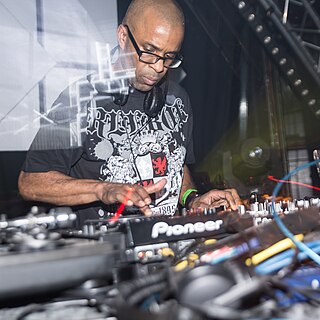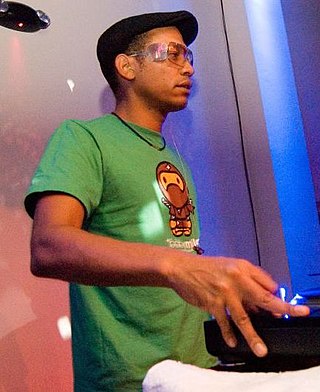
Drum and bass is a genre of electronic dance music characterised by fast breakbeats with heavy bass and sub-bass lines, samples, and synthesizers. The genre grew out of the UK's jungle scene in the 1990s.

Daniel Andrew Williamson, better known as LTJ Bukem, is a British drum and bass musician, producer and DJ. He and his record label Good Looking are most associated with the jazzy, atmospheric side of drum and bass music.
Breakbeat is a broad type of electronic music that tends to use drum breaks sampled from early recordings of funk, jazz, and R&B. Breakbeats have been used in styles such as Florida breaks, hip hop, jungle, drum and bass, big beat, breakbeat hardcore, and UK garage styles.
Microhouse, buftech or sometimes just minimal, is a subgenre of house music strongly influenced by minimalism and 1990s techno.
Deep house is a subgenre of house music that originated in the 1980s, initially fusing elements of Chicago house with the lush chords of 1980s jazz-funk and touches of soul music. Its origins are attributed to the early recordings of Larry Heard, including his influential track "Can You Feel It".
Electro is a genre of electronic dance music directly influenced by the use of the Roland TR-808 drum machines, with an immediate origin in early hip hop and funk genres. Records in the genre typically feature heavy electronic sounds, usually without vocals; if vocals are present, they are delivered in a deadpan manner, often through electronic distortion such as vocoding and talkboxing. It palpably deviates from its predecessor boogie by being less vocal-oriented and more focused on electronic beats produced by drum machines.
Broken beat is an electronic dance music genre characterized by syncopated beats and tense rhythms, including staggered or punctuated snare beats and/or hand claps. It has been heavily influenced by styles such as jazz-funk and R&B. Artists in this area typically emerged from the drum and bass, house, hip hop, techno or acid jazz scenes.

Dominick Martin, better known by his stage name Calibre, is a Northern Irish drum and bass music producer and DJ from Belfast. He is highly regarded for his influence on the liquid funk style of drum and bass, which was partially named after his distinct production style. He primarily releases his own works through his personal label, Signature Recordings, but has also released on labels such as Hospital Records, V Recordings, Creative Source and Soul:R.

Good Looking Records is a jungle and drum and bass record label, formed in 1991 by producer LTJ Bukem. The label specializes in jazz-influenced and atmospheric intelligent drum & bass.

Dance music is music composed specifically to facilitate or accompany dancing. It can be either a whole piece or part of a larger musical arrangement. In terms of performance, the major categories are live dance music and recorded dance music. While there exist attestations of the combination of dance and music in ancient history, the earliest Western dance music that we can still reproduce with a degree of certainty are old-fashioned dances. In the Baroque period, the major dance styles were noble court dances. In the classical music era, the minuet was frequently used as a third movement, although in this context it would not accompany any dancing. The waltz also arose later in the classical era. Both remained part of the romantic music period, which also saw the rise of various other nationalistic dance forms like the barcarolle, mazurka, ecossaise, ballade and polonaise.
Drum and bass is an electronic music genre that originated in the UK rave scene having developed from breakbeat hardcore. The genre would go on to become one of the most popular genres of electronic dance music, becoming international and spawning multiple different derivatives and subgenres.
Nu-disco is a 21st-century dance music genre associated with a renewed interest in the late 1970s disco, synthesizer-heavy 1980s European dance music styles, and early 1990s electronic dance music. The genre was popular in the early 2000s, and experienced a mild resurgence in the 2010s.
A number of overlapping punk rock subgenres have developed since the emergence of punk rock in the mid-1970s. Even though punk genres at times are difficult to segregate, they usually show differing characteristics in overall structures, instrumental and vocal styles, and tempo. However, sometimes a particular trait is common in several genres, and thus punk genres are normally grouped by a combination of traits.

DI.FM is an Internet radio broadcaster consisting of over 90 channels dedicated to electronic music, such as house, trance, techno, drum and bass, and dubstep. DI.FM broadcasts handpicked selections consisting of classic, new and up-and-coming hits, as well as weekly and monthly mixed shows from professional DJs. It was founded in December 1999 as a hobby project by Ari Shohat in his Binghamton University dorm room and was one of the first Internet radio stations. It has often been listed as one of the top internet radio stations.

Boogie is a rhythm and blues genre of electronic dance music with close ties to the post-disco style, that first emerged in the United States during the late 1970s to mid-1980s. The sound of boogie is defined by bridging acoustic and electronic musical instruments with emphasis on vocals and miscellaneous effects. It later evolved into electro and house music.
Avant-funk is a music style in which artists combine funk or disco rhythms with an avant-garde or art rock mentality. Its most prominent era occurred in the late 1970s and 1980s among post-punk and no wave acts who embraced black dance music.
Phonk is a subgenre of hip hop and trap music directly inspired by 1990s Memphis rap. The style is characterized by vocals from old Memphis rap tapes and samples from early 1990s hip hop, especially cowbell samples resembling that of the Roland TR-808 drum machine. The genre draws from the dark, distortive techniques of the chopped and screwed sound.








